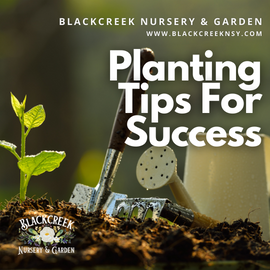 Planting Tips For Success
Planting Tips For Success
Nothing gives us more satisfaction than growing our own plants. Whether it’s for beauty, food, shade, or other functional purposes, growing plants can be rewarding and cost-saving. Your plant’s success is directly linked to its planting. You want to make sure that you are giving it the best start possible.
We’ve listed some tips here to help you get your plants off to a good start. This will apply to almost any container-grown plant.
Choosing the Right Plant For the Right Location
Planting success starts with making sure that you have the right plant going in the most optimal spot. If you have full sun area, then you may not want to put in a plant that requires shade. Likewise, if you have a wet area, you don’t want to put in a plant that won’t tolerate wet feet. Knowing where to plant your plants is the first step to plant success.
Water Before You Plant
The best thing to do when planting your plant is to make sure it’s well-hydrated. Thorough watering in the container will give the plant a little hydration and help it ease into its new spot.
Don’t Plant Too Deep – # 1 Killer of plants
The number one cause of plant failure when planting containerized plants is planting them too deep. The top of the root ball needs to be at or above ground level with very little, if any, soil on the top of the root ball. Dirt placed on top of the root ball can prevent water and oxygen from reaching the roots and will cause them to suffocate, dehydrate and tie. Mulch on top is suggested.
Avoid Air Pockets – # 2 Killer of plants
Just like planting too deep can cause extensive damage or death to plants, so can air pockets. When you plant you want to make sure that the backfilled soil is packed very tightly around the root ball. If you leave any air pockets, when you water the plant it will run down the sides and not through the rootball which can result in dehydration. Use a board or the end of your shovel to really pack the soil tightly around the roots to eliminate air pockets.
Don’t Foret Mulch
Mulching is the most important step in healthy plants. Mulch provides shade, moisture retention and organic matter as it breaks down. 2-4″ of mulch is usually adequate.
Steps to Planting For Success
- Water your plant in the containers before you plant
- Dig your hole about 1.5 times wider and only as deep as your container.
- Amend the soil you removed with compost or other organic matter if your soil is sandy. If your soil is clay or very compact, then you may want to use soil conditioner which is a very finely ground pine bark that will break up the soil to allow more oxygen.
- Don’t snatch your plant out of the pot by the stem. Put your hand on the root ball and turn the pot upside down then remove the pot.
- Loosen the root ball if it is tightly compacted. You can use a spade or a knife to make cuts in the roots – it will not hurt it at all and will encourage the roots to start growing again.
- Place your plant in the hole, with the top of the root ball slightly above ground level. It’s best to not put any dirt on top of the root ball
- Fill in the soil tightly around the sides of the pot, packing them in with a board or your shovel handle tightly so there are no air pockets.
- You will probably have some soil left and if you do, you can make a ring of soil a few inches high on the ground around the plant to create a well of sorts to keep water from running off.
- Mulch Heavily with 2-4″ of organic mulch. Bark, Straw, or leaves is always the best bet as they will break down and add nutrients and organic matter back to the soil – and improving the plant’s health.
- Avoid synthetic mulch like rocks or rubber mulch for general plants.
- Add organic fertilizer like Espoma Products which will aid in getting the plants established.
- Water well. Keep hydrated as they get acclimated according to the requirements of your plant.
Irrigation Systems Need Help With New Plants
Irrigation Systems are designed for ‘established plantings’. They are supposed to provide enough hydration to keep the plant with what it needs. But, you should not rely on them completely for new plantings.
Keep in mind that your plant still thinks it’s in the container. The roots are still in one place and it is accustomed to getting more frequent water. You may need to hand water it well for a few weeks to make sure it’s adequately hydrated. After the roots start to grow out in the surrounding soil then you can rely more on your irrigation system for its care.





